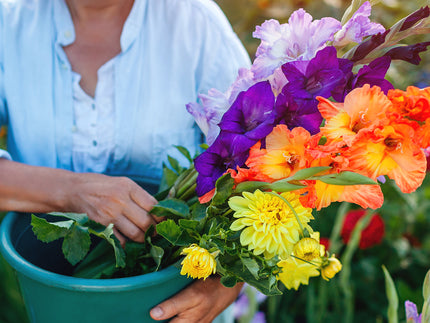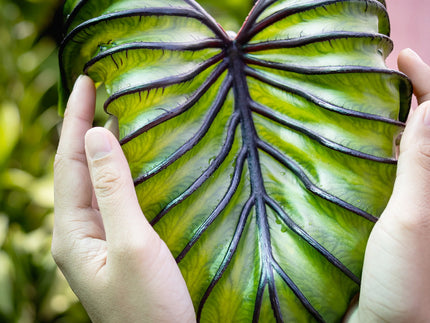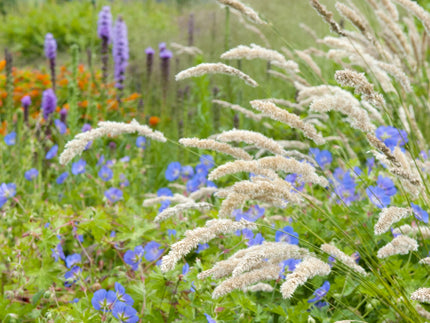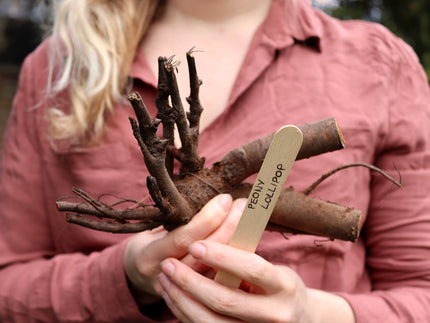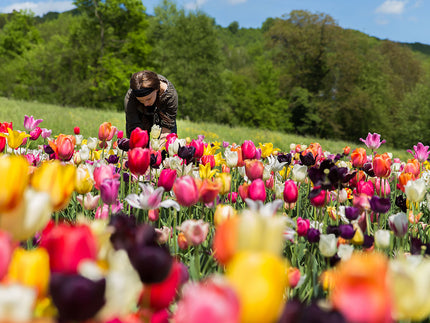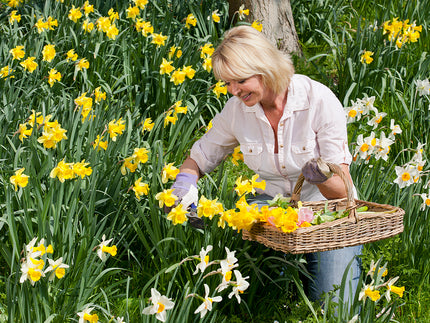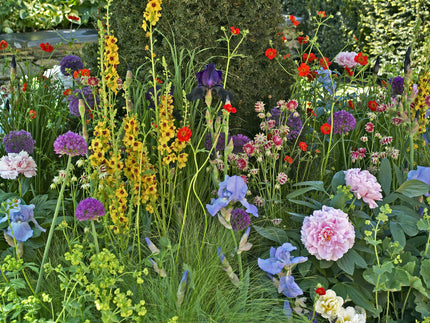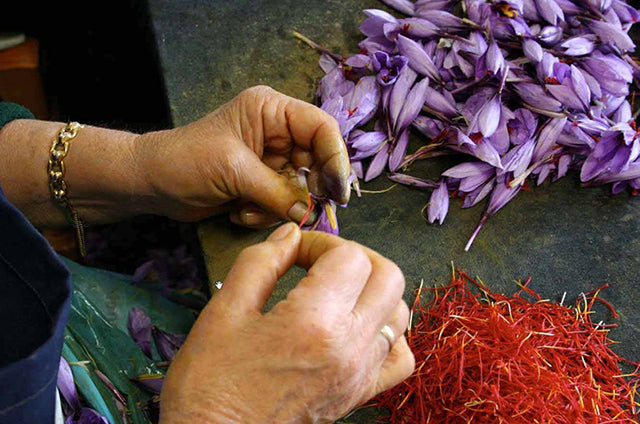
All about growing saffron from Crocus sativus bulbs
Saffron bulbs, or Crocus sativus, are known to be one of the most valuable plants to grow, not only for their show-stopping garden performance and wonderful autumn colour, but the saffron spice (also known as red gold) which is harvested from the Crocus sativus flowers is worth more than its equivalent weight in gold!

Picking saffron stigmas from Crocus sativus flowers
The saffron part of Crocus sativus is the three long red stigmas which grow from the centre of the bloom. These can be harvested from the flower by tweezing it out, then storing in an air-tight container. Saffron spice is prized for its unique and distinct flavour and colouring as well as multiple culinary uses, most often used in high-end restaurants. The saffron crocus flower is a pretty mauve colour and traditional crocus goblet shape.
Precious by value but not by nature, Crocus sativus is actually very easy to grow at home in your own garden, enabling you to harvest your own fresh saffron spice in autumn. It’s relatively unfussy when it comes to growing conditions, thriving in most soil types (aside from heavy clay) and enjoying full sun. Like most crocuses, it’s compact and dainty so you don’t have to have a huge space for it. While it does look fantastic and provide the best crop when grown in large swathes running through border, it’s perfectly happy in a patio container too.
What’s more, Saffron crocuses are fully hardy and perennial, naturalising over the years to form larger and more impressive groups and, perhaps more importantly, a higher yield of saffron.
Choose top-size saffron bulbs
Farmer Gracy supplies only top-size bulbs because they produce the strongest results, and Crocus sativus is no exception! Grow top-size and you’ll see the difference, with healthy, large blooms, strong stems and a brilliant crop in the first year.
Order your top-size Crocus sativus bulbs here.
How to grow saffron bulbs
Crocus sativus are grown from bulbs known as corms. Crocus corms are best planted in September, then will flower a couple of months later providing a blast of vibrant autumn colour during November.
Newly-planted saffron crocuses will put on a show the same year, but they do need time to establish before they really start to provide a high impact and a high yield. Over the years, the corms multiply under the ground, gradually naturalising and putting on a bigger, more impressive and full display each year afterwards.

Wonderful field of Crocus sativus in Spain
Plant Crocus sativus in any free-draining soil in full sun or very light partial shade. You can grow saffron in beds, borders or containers, but for best results and natural swathes, plant them in large groups where these delicate flowers can make a big impact and produce a generous crop.
Saffron corms have a pointed end and a rounded end. To plant your corms, create a hole about 15cm (8in) deep and position one bulb in each hole with the pointed end facing upwards. Position the corms around 10-15cm apart from each other. Give them a good soak with water after planting as the corm needs to be well hydrated in order to activate into growth. Your corms should begin to sprout after one to two months.

Life cycle and reproduction of a Crocus sativus bulb – illustration © Farmer Gracy
After flowering, leave the bloom and foliage to die back naturally so that it can continue to put energy back down to the bulb for next year’s display. The bulb can then sit underground before putting on a repeat show the following autumn.
When to water your saffron plants
Saffron reproduces from the corm. The first corm planted becomes the ‘mother’ bulb, which will produce several ‘daughter’ bulbs around it. The mother bulb then dies off leaving the daughter bulbs in charge of next year’s display. Crocus sativus corms reproduce more readily if they’re given a good dose of water during spring, helping them to naturalise quicker and also provide a bigger crop of saffron flowers the following season.
By watering your saffron bulbs in spring, you’ll be helping the mother bulbs to reproduce plenty of strong daughter bulbs. You should continue watering until the foliage goes yellow in early summer for best results.
How many saffron crocus bulbs do you need?
There’s very good reason why this tasty spice is so pricy – you need around 150 flowers to bring in a harvest of about 1g of the spice, which would set you back by about £75 if you were to buy it in the shops. Although 1g doesn’t seem a lot, if you’re growing them just for yourself and your family that’s enough to create a good few luxurious dishes. It’s important to remember that you don’t need to use a lot saffron at any one time. Just a few of the stigmas of this potent spice can often be enough to flavour various dishes, including desserts and savoury sauces.
If you’re growing on a commercial scale, plant the saffron bulbs at a spacing of 60 corms per square metre and it’s estimated that you can harvest 6-10kg of saffron per hectar (2.5 acres) with a retail value of up to £2,600.
How to harvest saffron
Once the flowers have emerged in autumn, pick the bloom from the top of the stem, preferably in the morning before the flowers have opened, leaving the green stem and foliage intact. Take the picked blooms indoors into a clean, dry environment and use tweezers to carefully pull the stigmas out from the base, positioning them on clean kitchen towel or canvas to begin drying.

Picking the Crocus sativus blooms in the field
For smaller yields, it’s possible to tweeze the stigmas from the blooms, leaving the blooms intact to continue the display.
How to dry and store saffron
Saffron can keep for years if harvested and stored carefully. The stigmas need to be fully dried out before storing which is very easy to do and just takes a few days – here’s how:
- Lie the stigmas onto clean kitchen towel, canvas sheets or a drying rack, positioning them carefully so that they aren’t touching.
- Leave in a warm, dry place to fully dry for 2-3 days. A sunny conservatory, windowsill, or close to a radiator is ideal.
- For storing, choose a small air-tight pot or jar – the less air movement the better. Also make sure the container is completely dry as any moisture in storage can ruin your saffron.
Once the stigmas are fully dry, put them into a small air-tight pot or jar and keep them in a cool, dark cupboard – an ordinary kitchen cupboard is ideal. Avoid putting them in the fridge as the fluctuation in temperature when used can create condensation in the container.
Cooking with saffron
Saffron has a pungent, earthy aroma and flavour which adds a distinct flavour to both sweet and savoury dishes. This labour-intensive crop is what makes it so expensive, so luckily you only need to use it sparingly.
When using saffron in the kitchen, it’s best to soak the dried stigmas for 30 minutes in a small amount of water first. Doing so not only helps to draw out the flavours, but also ensures an even distribution of flavour to the dish when added. Add the saffron and water to the dish towards the end of cooking to get the best flavour.

Risotto with saffron & Paella with saffron
Saffron goes well with numerous dishes, particularly fish dishes, paella, risotto, tomato, wine or cream-based sauces and fruit desserts.
Health benefits from saffron
This valuable spice is known to have some excellent health benefits, containing bioactive compounds including carotenoids, safranal, crocin, crocetin, antioxidants and vitamins. Common uses of the spice include:
- Immunity boosting – rich in vitamin C, saffron helps to strengthen the immune system to protect you against illness.
- Improved circulation and heart health – antioxidant and anti-inflammatory properties in saffron, combined cholesterol-lowering crocetin all helps to protect the heart. Iron stimulates circulation and increases metabolism, which in turn improves efficiency of the organs.
- Helps lower blood pressure – rich in potassium, saffron helps to reduce pressure and stress on blood vessels and arteries.
- Helps relieve stress and anxiety – saffron contains crocin and safranal which aid the brain’s release of dopamine and serotonin. People who regularly consume it report positive results.
- Improves nerve function – contains vitamin B which plays an important role in nerve function throughout the body.
Saffron – Quick tips
- Plant Crocus sativus from late August through to late September.
- Flowers during October or November in the first year.
- Naturalising variety, multiplying corms which produce a higher yield each year.

Crocus sativus flowers in Autumn
- Perfect for growing in any free-draining soil.
- Prefers full sun but can tolerate very light partial shade.
- Easy to grow and reliable.
Growing saffron on a commercial scale
Saffron can be successfully grown in various climates in locations with free-draining soil. The main saffron-growing countries include India, Iran, Spain, Greece and Italy. British-grown saffron is becoming highly sought after and is now grown in various parts of the UK, and is still grown in a small Essex Town called Saffron Walden.
Saffron pests and diseases
Saffron is generally a very resilient, reliable and easy crop, although when growing on a commercial scale it’s worth putting in precautions to protect the corms from being eaten by mice, rabbits or squirrels.
Crocus sativus is disease resistant. To avoid the corms from rotting or becoming mouldy, grow them in fertile, well-drained soil which doesn’t become waterlogged in the winter. There’s no need to spray chemicals or fertilisers on your crop.
To keep your saffron crop healthy, dig up the corms every 6-7 years and replant them in a new field. In the mean time you can replenish the minerals in your previous field by sowing nitrogen fixing varieties or a green manure.
How to maximise saffron crocus (Crocus sativus) reproduction
The single Crocus sativus corm which is planted becomes the ‘mother’ bulb, reproducing by forming smaller ‘daughter’ bulbs around it during the spring. The mother bulb in the centre then dies off, leaving just the daughter bulbs around it, which will grow and produce their own flowers the following season.
After flowering, it’s important to leave the foliage and stem intact to continue to put energy down to the corm. The mother bulb begins to produce daughter bulbs during spring, during which time it’s essential to provide plenty of water to the plants – the more water they receive, the bigger and healthy the new daughter bulbs will be. Continue watering saffron plants throughout spring until the foliage begins to turn yellow in early summer.
Picking and harvesting Crocus sativus bulbs on a commercial scale
Flowers generally appear in October although often slightly later in the first year, and continue to bloom for one month or more.
There are two main methods of harvesting saffron:
- Tweezing the stigmas from the flowers in situ, which is a good method when there are smaller quantities of flowers. It’s important to have a clean container to put the harvested stigmas into and to avoid them having any contact with the soil to avoid contamination.
- For large-scale harvesting, the entire blooms should be picked as soon as they fully emerge. Once the blooms have been picked, use tweezers to extract the stigmas from each flower. This should be done within a few hours of picking.

Extracting the stigmas should be done within a few hours of picking
Commercial processes for drying saffron
The stigmas must be completely dried out before they’re stored. When carefully harvested and stored, they can be preserved for several years.
As soon as the stigmas are trimmed or tweezed from the blooms, they should be positioned on drying racks of clean canvas or similar and kept in a dry, ventilated space at a temperature of around 30-60°C or under the sun outside where conditions are warm enough and not breezy.
Once dried, saffron should be stored in small air-tight containers, ideally tins or glass jars and stored in a cool, dark place for around one month prior to consumption.
Buy wholesale Crocus sativus bulbs
For larger quantities, please contact us






















































































































































































